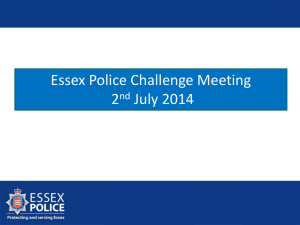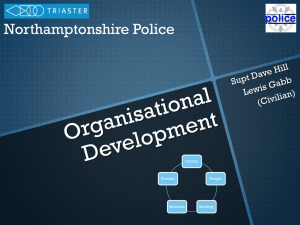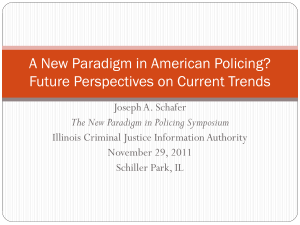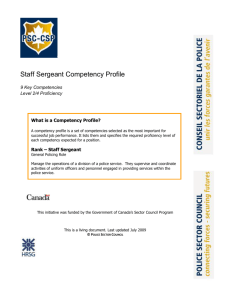0002_2060_lesson_plan - West Midlands Police
advertisement
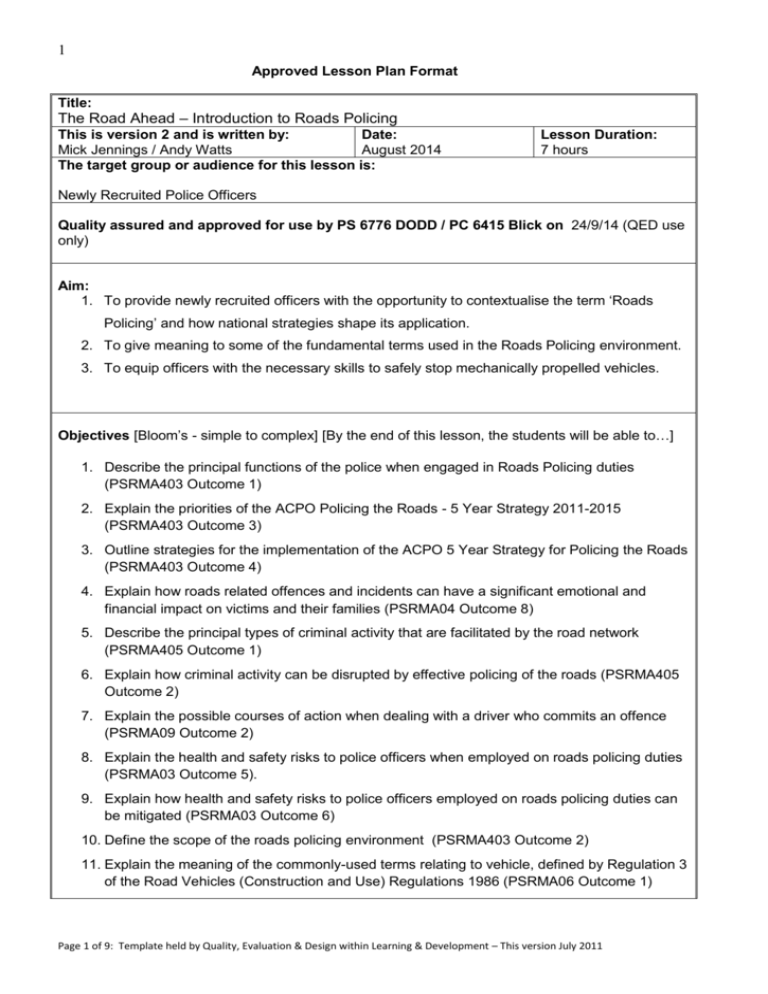
1 Approved Lesson Plan Format Title: The Road Ahead – Introduction to Roads Policing This is version 2 and is written by: Date: Mick Jennings / Andy Watts August 2014 The target group or audience for this lesson is: Lesson Duration: 7 hours Newly Recruited Police Officers Quality assured and approved for use by PS 6776 DODD / PC 6415 Blick on 24/9/14 (QED use only) Aim: 1. To provide newly recruited officers with the opportunity to contextualise the term ‘Roads Policing’ and how national strategies shape its application. 2. To give meaning to some of the fundamental terms used in the Roads Policing environment. 3. To equip officers with the necessary skills to safely stop mechanically propelled vehicles. Objectives [Bloom’s - simple to complex] [By the end of this lesson, the students will be able to…] 1. Describe the principal functions of the police when engaged in Roads Policing duties (PSRMA403 Outcome 1) 2. Explain the priorities of the ACPO Policing the Roads - 5 Year Strategy 2011-2015 (PSRMA403 Outcome 3) 3. Outline strategies for the implementation of the ACPO 5 Year Strategy for Policing the Roads (PSRMA403 Outcome 4) 4. Explain how roads related offences and incidents can have a significant emotional and financial impact on victims and their families (PSRMA04 Outcome 8) 5. Describe the principal types of criminal activity that are facilitated by the road network (PSRMA405 Outcome 1) 6. Explain how criminal activity can be disrupted by effective policing of the roads (PSRMA405 Outcome 2) 7. Explain the possible courses of action when dealing with a driver who commits an offence (PSRMA09 Outcome 2) 8. Explain the health and safety risks to police officers when employed on roads policing duties (PSRMA03 Outcome 5). 9. Explain how health and safety risks to police officers employed on roads policing duties can be mitigated (PSRMA03 Outcome 6) 10. Define the scope of the roads policing environment (PSRMA403 Outcome 2) 11. Explain the meaning of the commonly-used terms relating to vehicle, defined by Regulation 3 of the Road Vehicles (Construction and Use) Regulations 1986 (PSRMA06 Outcome 1) Page 1 of 9: Template held by Quality, Evaluation & Design within Learning & Development – This version July 2011 2 12. Associate the Highway Code with the philosophy of Roads Policing (WMP Outcome) 13. Explain why “using, causing and permitting” are central to many road traffic offences involving construction and use of vehicles (PSRMA407 Outcome 1) 14. Explain the power provided under section 163 of the Road Traffic Act 1988 for stopping a vehicle (PSRMA406 Outcome 11) 15. Describe the powers conferred when a driver or rider fails to stop when required to do so (PSRMA406 Outcome 13) 16. Outline the general considerations to be taken into account when stopping a vehicle on a road (PSRMA406 Outcome 12) 17. Demonstrate the safe stopping of a motor vehicle whilst on foot (WMP Outcome) 18. Describe the roles played by partner agencies in relation to policing the roads (PSRMA03 Outcome 7) Legislation – Policies – Part One Orders Example: Section 1 Theft Act 1968) Road Traffic Act 1988 Road Vehicles (Construction and Use) Regulations 1986 Road Vehicles (Display of Registration Marks) Regulations 2001 Road Traffic Regulation Act 1984 Highways Act 1980 Town Police Clauses Act 1847 Health & Safety Act 1974 College of Policing Code of Ethics West Midlands Police Force Values Resources (list any alternatives that may be needed) PowerPoint (optional) Sufficient terminals to access online Highway Code exam 21 x Highway Code test papers & answer sheets (in event of computer issues) 4 x Hughes Guide to Traffic Wilkinson’s Road Traffic Offences College of Policing Introduction to Roads Policing Student Notes 2 x unmarked cars and drivers for practical exercise Areas researched or agencies consulted : (Blackstone’s – Internet & Intranet sites – PNLD – Part One Orders, Equality Commission Publications, Rainbow etc) Road Traffic Act 1988 Traffic Signs Manual 2009 Chapter 8 NPIA (2007) Practice Advice on the Policing of Roads College of Policing Initial Learning Student Notes ‘An Introduction to Policing the Roads’ College of Policing Initial Learning Student Notes ‘Disrupting Criminality and Countering Terrorism’ Page 2 of 9: Template held by Quality, Evaluation & Design within Learning & Development – This version July 2011 3 College of Policing Initial Learning Student Notes ‘Vehicles and Related Offences’ ROSPA College of Policing Authorised Professional Practice – Disrupting Criminality Internet – various sites Highway Code Hughes Guide to Traffic Law Wilkinson’s Road Traffic Offences 26th Edition Pre-course requirements (Previous course – Completion of e-learning – other certification) Students to have read the Highway Code – copies distributed in the week prior to this lesson. . Diversity related considerations a) Specific Protected Characteristics relating to this lesson plan: (delete as needed) Age / Disability / Gender / Race / Religion / Sexual Orientation/ Transgender / Marriage & Civil Partnership / Pregnancy & Maternity. b) Identify any concerns or considerations in relation to the protected characteristics? Explain those measures put in place to manage any potential negative impact. Consideration has been given to the terminology, circumstances and names used in scenarios and practical exercises so as not to discriminate against or reinforce stereotypes of any of the Protected Characteristics. c) How does the lesson plan and support material actively eliminate unlawful discrimination, encourage participation, promote equality of opportunity, promote good race relations and positive attitudes in line with current legislation and the force equality schemes? This lesson plan has been Quality Assured in accordance with force guidance and all questions used to evaluate learning have been accredited by the College of Policing. Wherever possible previously quality assured/accredited material has been used and all content will be subject to continuous review and amended as necessary. All material has been developed with consideration at all times to Force Values and the Code of Ethics. Outside agency standards This section is where a lesson plan is required to meet the criteria for an external awarding body. Examples being NOS for student officers, ICILDP for trainee detectives etc College of Policing National Policing Curriculum (IPLDP) Page 3 of 9: Template held by Quality, Evaluation & Design within Learning & Development – This version July 2011 4 Methodology (Does the Trainer need a particular qualification to train this lesson? Indicate the facilitative method – you must detail where objectives will be met and how this will be checked) The content of this lesson may appear quite complicated and it is recommended should be delivered by a competent practitioner of the subject. Whilst opportunities should be taken for class discussion or peer-to-peer learning, it is inevitable that some of the material may need to be delivered in a hierarchical style. This lesson will be delivered to ensure compliance with The Code of Ethics, Policing Principles, and Standards of Professional Behaviour, integrating them throughout. Learning will assessed by the following methods: Continuous assessment by the instructors Practical exercise (where applicable) Debrief of practical exercise (where applicable) Reflective practice Written test Time Objectives 0830 Introductions and how it is proposed to deliver the roads policing subjects over the eight days. Include a degree of NCE including those of the instructors, i.e. appearance. 0900 QUESTION – What is Roads Policing? Why do we police the roads? What are we aiming to do? What does the public expect of us? CoP responses Ensuring the health and safety of themselves and other road users Setting a professional example when driving, using the road or responding to incidents Developing relationships with the community, leading to the gathering of intelligence and information that will help in disrupting criminality and reducing crime Having knowledge of legislation and policies relating to driver and vehicle offences Taking every opportunity to intervene and address driver behaviour by education, Page 4 of 9: Template held by Quality, Evaluation & Design within Learning & Development – This version July 2011 5 Time Objectives advice and enforcement Stopping and seizing (where appropriate) vehicles that have been or are suspected to be involved in crime Attending and managing incidents where there may be death or injury and/or damage to vehicles and the road infrastructure Investigating and disposing of offences committed in the roads environment This will be an opportune moment to discuss officer behaviour (on and off duty) drawing from Force Values and Code of Ethics. The trainer should make reference to research from ROSPA et al that drivers and riders in the 16-24 year old age group are disproportionately more likely to be involved in collisions than any other age group. (Objective 1 achieved) 0905 Debrief responses introducing the ACPO 5 year strategy Explain the priorities of the ACPO Policing the Roads - 5 Year Strategy 20112015 Reducing Road Casualties Disrupting Criminality Countering Terrorism Patrolling the Roads Combating Anti-Social Road Use Discuss how we can achieve the ACPO priorities and what types of criminal use the road network and how roads related offences and incidents can have a significant emotional and financial impact on victims and their families. (Objectives 2, 3, 4, 5 & 6 achieved) Discuss possible courses of action to deal with offenders (Objective 7 achieved) Move discussion towards the inherent dangers associated with Roads Policing. Page 5 of 9: Template held by Quality, Evaluation & Design within Learning & Development – This version July 2011 6 Time Objectives What are the health & safety risks to police officers when employed on roads policing duties? LIST responses on boards Expected responses Traffic Weather Fatigue Stress (Objective 8 achieved) How can we mitigate these? MAP responses against previous list (Objective 9 achieved) 0930 However, before policing the roads, officers must understand a few terms connected to the activity. Define the scope of the roads policing environment. (spot questions, allowing group to look up correct answer in Student Notes or other literature) Definitions The terms ‘road’ and ‘other public place’ as specified in Section 192 (1) of the Road Traffic Act 1988 The term ‘highway’ as it applies to Section 5 of the Highways Act 1835 The term ‘carriageway’ as it applies to Section 329 of the Highways Act 1980 The term ‘driver’ as it applies to section 92(1) of the Road Traffic Act 1988 When a person may be said to be ‘driving’ The term ‘mechanically propelled vehicle’ The term ‘motor vehicle’ as it applies to section 185(1) of the Road Traffic Act 1988 ‘Motor car’ ‘Goods vehicle’ ‘Passenger vehicle’ ‘Minibus’ IF INSUFFICIENT TIME - SET AS HOMEWORK ‘Bus’ ‘Invalid carriage’ ‘Motorcycle’ (Objectives 10 & 11 achieved) Page 6 of 9: Template held by Quality, Evaluation & Design within Learning & Development – This version July 2011 7 Time 1015 Objectives MORNING BREAK 1030 “If we are responsible for enforcing Road Traffic legislation, do you think we should know all the rules ourselves?” TEST – online Highway Code knowledge exam (max. 45 mins). Divide class into pairs/three for online Highway Code test accessible via the Driver Development website (Intranet - HQ Departments - Learning & Development - Delivery Teams - Driver Development - Online Theory Assessments) INDEX Pairs/three should be tasked to complete the test without reference material. The pair that scores the highest (fastest time in the event of a tie) will receive a nominal prize. This will incorporate peer-to-peer learning, gentle competition and the possibility of selfrealisation that further learning of the Highway Code is necessary to be on par with colleagues. (Objective 12 achieved) 1130 Use, Cause, Permit Discuss the fact that many Road Traffic offences have different degrees of involvement. Discuss the differences between Using, Causing and Permitting. (Objective 13 achieved) 1215 LUNCH 1310 Stopping Vehicles Section 163 Road Traffic Act 1988 A person driving a mechanically propelled vehicle on a road, or riding a cycle on a road, must stop on being required to do so by a constable in uniform, a traffic warden or a traffic officer. DISCUSS what this means and circumstances when a driver must stop for a constable. Does the constable need a reason? (Objective 14 achieved) Fail to Stop Page 7 of 9: Template held by Quality, Evaluation & Design within Learning & Development – This version July 2011 8 Time Objectives It is an offence to fail to comply with this section and there is a power of entry under PACE (Objective 15 achieved) Traffic Regulation Section 35 Road Traffic Act 1988 Where a constable, a traffic warden or a traffic officer is engaged in the regulation of traffic in a road it is an offence for a person driving or propelling a vehicle to neglect or refuse: To stop the vehicle To make it proceed in, or keep to a particular line of traffic, or In the event of a traffic survey in the vicinity of a road, to proceed to a particular point on or near the road when directed to do so by the constable in the execution of his duty, a traffic warden or a traffic officer. 1330 GROUP ACTIVITY – in your groups draw up a list of considerations when stopping vehicles both on foot and from a police vehicle and how any risks identified may be minimised (10 mins). 1340 1410 Debrief group responses thereby creating a form of dynamic risk assessment for the safe stopping of vehicle. (Objective 16 achieved) PRACTICAL – stopping a car on foot Split class into two groups, each with a RP Instructor. Two further instructors required as drivers of cars. Cars to follow a circular route from Pebble Mill Road, Pershore Road, Priory Road, Bristol Road back into Pebble Mill Road. Continue travelling route until duration of exercise. (Radio comms. maybe appropriate). Students to be taken to a suitable stopping point on Pershore Road and Bristol Road (consider using a minibus for transport to Bristol Road). Instructor to demonstrate the safe stopping of one of the vehicles before tasking students to stop one of the control vehicles. Instructor to also undertake role of safety officer. (Objective 17 achieved) 1510 DEBRIEF – canteen Homework Read Student Notes ‘Introduction to Policing the Roads’ and pages 16-18 & 26-27 of ‘Vehicles and Related Offences’. (Objective 18 achieved) Review today’s learning for test (definitions). Bring in Driving Licences for tomorrow’s lesson. 1530 END Page 8 of 9: Template held by Quality, Evaluation & Design within Learning & Development – This version July 2011 9 Page 9 of 9: Template held by Quality, Evaluation & Design within Learning & Development – This version July 2011
